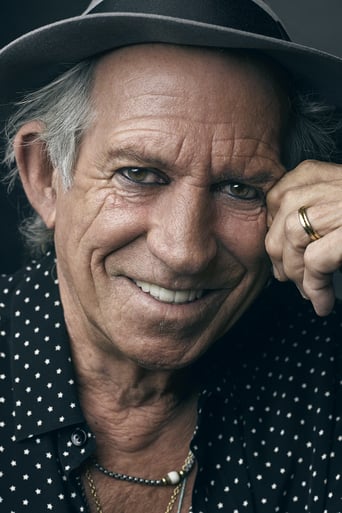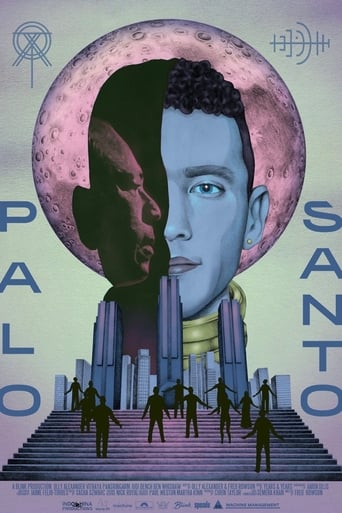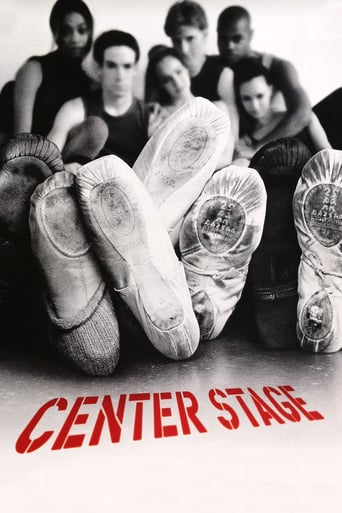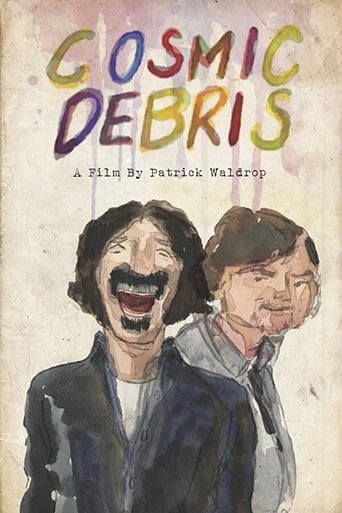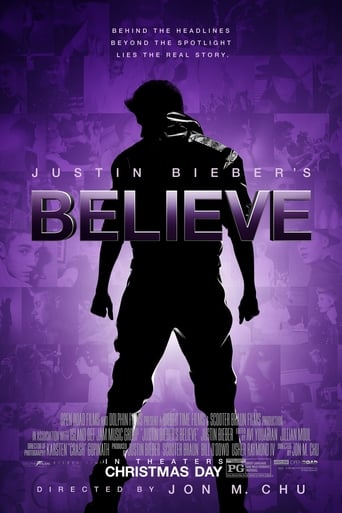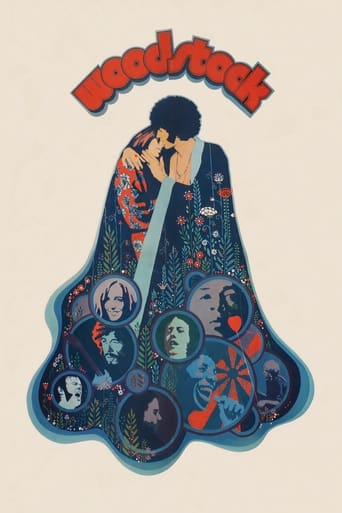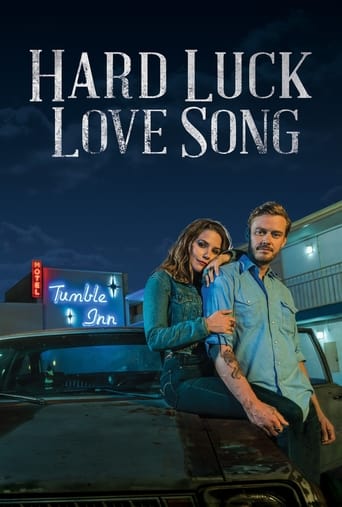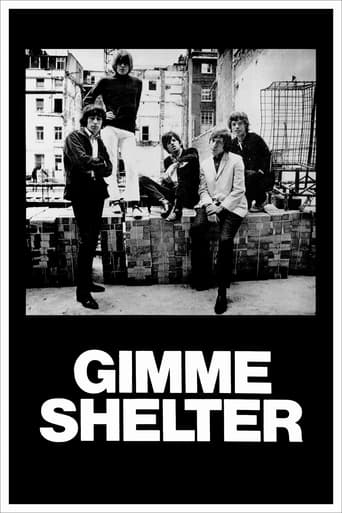
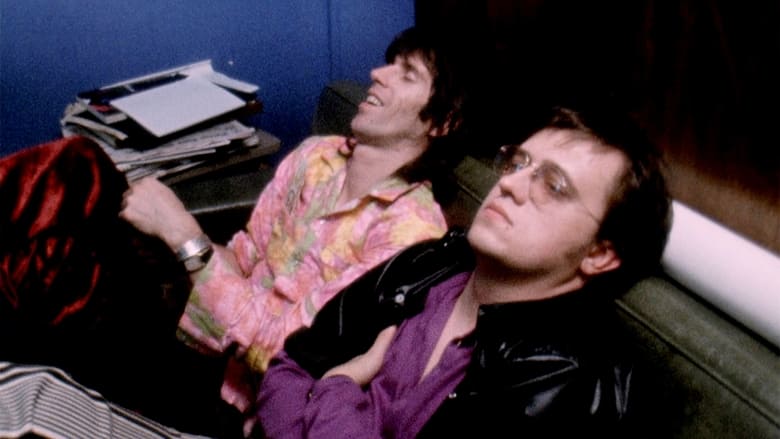
Gimme Shelter (1970)
A detailed chronicle of the famous 1969 tour of the United States by the British rock band The Rolling Stones, which culminated with the disastrous and tragic concert held on December 6 at the Altamont Speedway Free Festival, an event of historical significance, as it marked the end of an era: the generation of peace and love suddenly became the generation of disillusionment.
Watch Trailer
Cast


Similar titles
Reviews
I had seen the first 15 minutes of Gimme Shelter in my film class around two weeks ago. Today I decided to watch all of it, because what I had seen had intrigued me. This is a pretty fascinating documentary that mostly focuses on the events of that night in Altamont. I haven't heard much of the Rolling Stones' music, and had never seen Mick Jagger in motion. The film especially shows how incredibly powerful his stage presence and performance was, and that itself makes it easy to watch from the start. The final act is hectic, and at the same time it feels like what you would feel in that situation. The sketchy editing and the on- the-wall observation of the events remains fascinating to watch, even when it's also disturbing. Worth a watch.
While I had previously seen this film on tape that I recorded off AMC, that cassette didn't record the whole thing so it wasn't until I just watched it on YouTube that I saw the murder that pretty much ended the picture. If I didn't already read about it on various internet articles, I wouldn't have known about the gun that murdered man had that he presumably intended to use on that Hell's Angel that stabbed him. This film, Gimme Shelter, is both enjoyable for the performances of The Rolling Stones and others like Ike and Tina Turner, Jefferson Airplane, and The Flying Burrito Brothers, and upsetting for all those scenes of those Hell's Angels constantly beating up on several audience members not to mention some of the musicians like Airplane's Marty Balin. And seeing Mick Jagger's face after seeing the whole thing on the view finder makes one wonder how he could have continued the way he did after that. Still, at least during those Madison Square Garden performances of The Stones and The Turners, you could marvel at the way they put themselves out there. I especially loved the way Tina stroked that microphone and its handle! And while the camera is mostly on the audience and their scuffles when the other acts are playing at Altamont Speedway, at least you can hear what they're singing when that happens. So on that note, Gimme Shelter is one of the most compelling of concert documentaries from this most interesting era in Rock music. Kudos to David and Albert Maysles and Charlotte Zwerin.
(contains spoilers) Filmed over the course of ten days, Gimme Shelter is the film that catapulted The Maysles' Brothers and Charlotte Zwerin to the forefront of "direct cinema" – a term the Maysles' coined and preferred over the highly assumptive "cinema vérité". As originally planned, Gimme Shelter was to be a celebratory document of The Rolling Stones' 1969 tour of the U.S. that began with the Thanksgiving show at Madison Square Garden which opens the film, and ended with the free concert given at the Altamont Speedway near San Francisco. What the Maysles', Zwerin and their crew ended up with though, was the celluloid equivalent of an autopsy – the body dissected is the 1960s itself. In fact the only other movie that tenses me up more than Gimme Shelter is Stan Brakhage's faceless autopsy-room documentary The Act of Seeing With One's Own Eyes, a title that could be transposed with the Maysles' film. Cynical? Perhaps. But before Gimme Shelter, never before in a film had the actions of the micro reflected the failures of the macro in such a telling and startling way. Both Brakhage's and the Maysles' films depict decay, disintegration, the cold, harsh reality that befalls everything, be it life or credo.But what makes a decade? This ethereal term we use to describe a grouping of ten years is always loaded with highly distinct connotations of its particular time – some are arguable, some are universally accepted. Strangely enough, despite whatever man-made structure the 'decade' has as its skeleton, key social and historical events always seem to occur soon before, during or immediately after its cusp, events that serve as both endings and beginnings. The moment that defines the passing of one decade into another is always open for debate. However, the actions that transpire in this brilliant and sobering film actually give flesh, albeit bloodied, to the unarguable exact cusp between the 1960s and the 1970s.Was Woodstock, which had been only four months before, a fluke? Half a million people coming together, without serious incident, for three days of peace, harmony, music, and love. Incredible evidence that the progressive love-work of the decade had accomplished its promises. Yet in Gimme Shelter half that number of people swirl into an abyss. And at its obscure center are The Rolling Stones themselves – charismatic to no end, yet languorous and floating in ennui. Whether they were primadonnas or not that night, once Mick Jagger hits the stage he truly becomes the foreboding dark-knight, the chanting shaman, the sinister devil's agent, all those labels with which he'd (and still has) been copiously laden.The event that made Altamont (and therefore this film) infamous – the death of Meredith Hunter at the hands of stage security Hell's Angels – is disclosed at the beginning, much like film noir actually, making the 80-minute interim before the fact be all the more nail-biting. So powerful is the actual murder scene – when you know what's going on, but no one else really does (or do they?) – that I doubt you'll ever be able to listen to "Under My Thumb" again without thinking of Gimme Shelter, and this indelible moment. Meredith Hunter's loud green suit. The Hell's Angel stabbing him twice in what looks like the back of the neck. Does Mick notice what's going on? One moment you think so. The next it's hard to tell. All the while he's singing, " I can still look at someone else." It's chilling as well that the closing, repeated refrain of that particular song is, "Take it easy, babe "In Woodstock, the 'happenings' are all jovial. When you see people tripping out or high, it comes across as good vibes. In Gimme Shelter, the Maysles' didn't shy away from the bad trips. Look at the faces of those squashed against the stage during the climax; the chilling, paisley-clad hippie during "Under My Thumb" whose just to the right of Mick – it's like watching a lysergically-infused lycanthrope going through the moon-change; the frenzied, seemingly autonomous (thereby anti-hippie) dances during the Jefferson Airplane's "The Other Side of Life"; even Mick Jagger himself gets hated on the moment he lands at the Speedway. It's as if the whole day was cursed from the start. Urban legend has it that Kenneth Anger had done just that to Mr. Jagger, for only months prior he dropped out of the lead role in Anger's Lucifer Rising (leaving Anger high and dry), and for not properly acknowledging Anger's influence on his songwriting, namely "Sympathy For the Devil".Once the murder had been recognized in the editing room, did the Maysles' choose to make Gimme Shelter one big bad vibe, or was that all they had to work with? We'll probably never know for certain. But by most accounts of those who were really at Altamont, it was no editing ploy. The decade ended that cold early December day, but at least it was able to die where it was born. "It's down to me, the change has come " Indeed.
I haven't seen this in a few years, I'd like to see it again, so excuse my vagueness.But all I remember of this film is that it was mesmerizing to watch.Maybe some of the other comments here are right, that the film making was lacking, but as for the images; well they speak for themselves. The first 10-15 minutes, on the road (I think) document the groupie/hippie scene way better than any movie since.The way the camera lingers, it felt like a Wiessman film. I just can't get enough of not being to told what to think; you watch a group of people in the frame for minutes on end, and you can make up your own mind. Or not.




